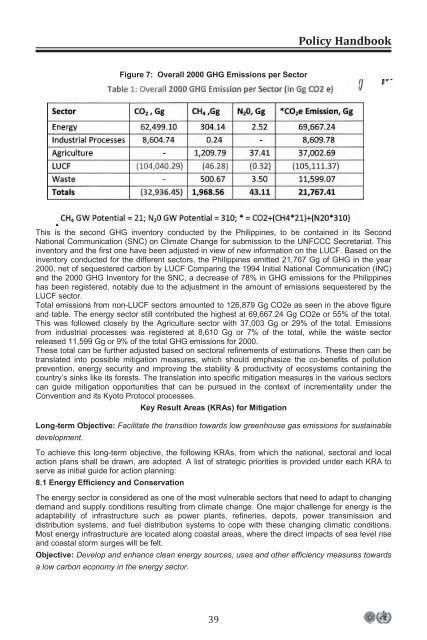National Framework Strategy on Climate Change Policy 2010-2022 Handbooktransport, agriculture, and industry, this framework endeavors to integrate mitigation with adaptationand take into account the circumstanceMitigation strategies in the Philippine development context offer opportunities for enhancingdevelopment and boosting the adaptation capacity of communities. In the same vein, adaptation is asmuch a development concern as mitigation. With the context of global-scale shifts in the climatesystem, development can only succeed if mitigation strategies such as energy efficiency andconservation, renewable energy development, environmentally-sustainable transport, sustainableinfrastructure, and Reduction of Emissions from Deforestation and Forest Degradation (REDD+) areundertaken in the context of adaptation. The development of a framework that integrates adaptationwithin the development process is deemed to ensure sustainability and success (WRI, 2007).An integrated approach builds on mitigation measures as a part of adaptation in order to providenecessary mechanisms to respond to the realities of climate change and contribute to attaining thetwin objectives of the UNFCCC and create an enabling policy environment for strengthening thecountry’s pursuit of sustainable development and the fulfillment of its Millennium Development Goals(MDG) targets.8. THE MITIGATION PILLARThe principal objective of the UNFCCC is the stabilization of GHG concentrations in the atmosphereat a level that prevents dangerous anthropogenic interference of the global climate system. Mitigationas a response plays a key role in pursuing the UNFCCC objective, particularly in the context ofhistorical emissions of industrialized countries. Achieving this objective would involve limiting orreducing anthropogenic GHG emissions by sources and preserving or, as appropriate, enhancingsinks and reservoirs of GHGs. However, the complexity of prevention and mitigation stems from thefact that the atmosphere is part of the global commons and as such, no single country, region, oreconomic sector can, reverse the trend of increasing GHG emissions by itself.Like most developing countries, the Philippines’ contribution to the total global GHG emissions isinsignificant compared to the rest of the world. Nonetheless, the Philippines embarks on a mitigationstrategy to contribute to the global effort to reduce emissions, pursuing cost-effective measures toreduce GHG emissions, including increased energy efficiency and conservation, development andincreased utilization of appropriate low carbon and renewable energy technologies, and reducingemissions from deforestation and forest degradation. The strategy shall take the form of nationallyappropriatemitigation actions, which reflects the recognition of the key role that developing countriesplay in ensuring that the global community can achieve the long-term objectives of mitigation, takinginto account the rising emissions growth rates of developing countries including the Philippines. Suchan approach to mitigation, anchored on the pursuit of sustainable development, gives the country theopportunity to leapfrog into the future and avoid harmful emissions as the economy grows.It is important to understand the mitigation potential of the Philippines although greenhouse gasmitigation will not be the primary driver of the country’s mitigation strategies as enshrined in thisFramework and the subsequent Action Plan. This potential should be transformed strategically intomitigation options that will offer the most co-benefits to fuel sustainable developments.The Philippines 2000 Greenhouse Gas (GHG) InventoryThe Philippine’s mitigation potential canbe gleaned from the GHG inventory,which is summarized in the followingfigure and table:3838
National Framework Strategy on Climate Change Policy 2010-2022 HandbookFigure 7: Overall 2000 GHG Emissions per SectorThis is the second GHG inventory conducted by the Philippines, to be contained in its SecondNational Communication (SNC) on Climate Change for submission to the UNFCCC Secretariat. Thisinventory and the first one have been adjusted in view of new information on the LUCF. Based on theinventory conducted for the different sectors, the Philippines emitted 21,767 Gg of GHG in the year2000, net of sequestered carbon by LUCF Comparing the 1994 Initial National Communication (INC)and the 2000 GHG Inventory for the SNC, a decrease of 78% in GHG emissions for the Philippineshas been registered, notably due to the adjustment in the amount of emissions sequestered by theLUCF sector.Total emissions from non-LUCF sectors amounted to 126,879 Gg CO2e as seen in the above figureand table. The energy sector still contributed the highest at 69,667.24 Gg CO2e or 55% of the total.This was followed closely by the Agriculture sector with 37,003 Gg or 29% of the total. Emissionsfrom industrial processes was registered at 8,610 Gg or 7% of the total, while the waste sectorreleased 11,599 Gg or 9% of the total GHG emissions for 2000.These total can be further adjusted based on sectoral refinements of estimations. These then can betranslated into possible mitigation measures, which should emphasize the co-benefits of pollutionprevention, energy security and improving the stability & productivity of ecosystems containing thecountry’s sinks like its forests. The translation into specific mitigation measures in the various sectorscan guide mitigation opportunities that can be pursued in the context of incrementality under theConvention and its Kyoto Protocol processes.Key Result Areas (KRAs) for MitigationLong-term Objective: Facilitate the transition towards low greenhouse gas emissions for sustainabledevelopment.To achieve this long-term objective, the following KRAs, from which the national, sectoral and localaction plans shall be drawn, are adopted. A list of strategic priorities is provided under each KRA toserve as initial guide for action planning:8.1 Energy Efficiency and ConservationThe energy sector is considered as one of the most vulnerable sectors that need to adapt to changingdemand and supply conditions resulting from climate change. One major challenge for energy is theadaptability of infrastructure such as power plants, refineries, depots, power transmission anddistribution systems, and fuel distribution systems to cope with these changing climatic conditions.Most energy infrastructure are located along coastal areas, where the direct impacts of sea level riseand coastal storm surges will be felt.Objective: Develop and enhance clean energy sources, uses and other efficiency measures towardsa low carbon economy in the energy sector.3939
















